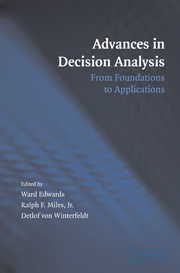Book contents
- Frontmatter
- Contents
- List of Contributors
- Preface
- 1 Introduction
- PART I HISTORY AND FOUNDATIONS OF DECISION ANALYSIS
- PART II STRUCTURING DECISION PROBLEMS
- PART III PROBABILITIES AND BAYES NETS
- 8 Eliciting Probabilities from Experts
- 9 Aggregating Probability Distributions
- 10 Model Building with Belief Networks and Influence Diagrams
- 11 A Bayesian Approach to Learning Causal Networks
- PART IV UTILITIES
- PART V RISK ANALYSIS
- PART VI DECISION ANALYSIS IN A BEHAVIORAL AND ORGANIZATIONAL CONTEXT
- PART VII APPLICATIONS OF DECISION ANALYSIS
- Index
- References
11 - A Bayesian Approach to Learning Causal Networks
Published online by Cambridge University Press: 05 June 2012
- Frontmatter
- Contents
- List of Contributors
- Preface
- 1 Introduction
- PART I HISTORY AND FOUNDATIONS OF DECISION ANALYSIS
- PART II STRUCTURING DECISION PROBLEMS
- PART III PROBABILITIES AND BAYES NETS
- 8 Eliciting Probabilities from Experts
- 9 Aggregating Probability Distributions
- 10 Model Building with Belief Networks and Influence Diagrams
- 11 A Bayesian Approach to Learning Causal Networks
- PART IV UTILITIES
- PART V RISK ANALYSIS
- PART VI DECISION ANALYSIS IN A BEHAVIORAL AND ORGANIZATIONAL CONTEXT
- PART VII APPLICATIONS OF DECISION ANALYSIS
- Index
- References
Summary
ABSTRACT. Bayesian methods have been developed for learning Bayesian networks from data. Most of this work has concentrated on Bayesian networks interpreted as a representation of probabilistic conditional independence without considering causation. Other researchers have shown that having a causal interpretation can be important because it allows us to predict the effects of interventions in a domain. In this chapter, we extend Bayesian methods for learning acausal Bayesian networks to causal Bayesian networks.
There has been a great deal of recent interest in Bayesian methods for learning Bayesian networks from data (Spiegelhalter and Lauritzen 1990; Cooper and Herskovits 1991, 1992; Buntine 1991, 1994; Spiegelhalter, Dawid, Lauritzen and Cowell 1993; Madigan and Raftery 1994; Heckerman et al. 1994, 1995). These methods take prior knowledge of a domain and statistical data and construct one or more Bayesian-network models of the domain. Most of this work has concentrated on Bayesian networks interpreted as a representation of probabilistic conditional independence. Nonetheless, several researchers have proposed a causal interpretation for Bayesian networks (Pearl and Verma 1991; Spirtes, Glymour, and Scheines 1993; Heckerman and Shachter 1995). These researchers show that having a causal interpretation can be important because it allows us to predict the effects of interventions in a domain – something that cannot be done without a causal interpretation.
In this paper, we extend Bayesian methods for learning acausal Bayesian networks to causal Bayesian-networks learning.
- Type
- Chapter
- Information
- Advances in Decision AnalysisFrom Foundations to Applications, pp. 202 - 220Publisher: Cambridge University PressPrint publication year: 2007
References
- 7
- Cited by



